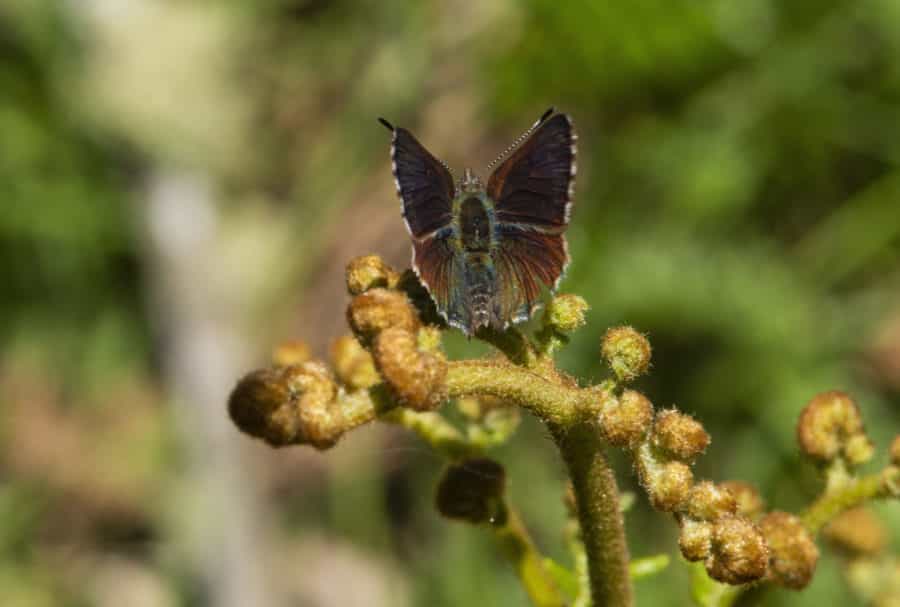Blink and you’ll miss it: meet the purple copper butterfly

WITH A TINY wingspan of around 20mm and a flying period of just two weeks a year, it’s not the easiest of tasks to track down the incredibly elusive purple copper butterfly.
But that’s exactly what residents in a small regional area in NSW are being encouraged to do as part of an annual monitoring program that takes place in September and October each year.
Also known as the Bathurst copper butterfly in honour of its Central Tablelands home, the species has been classified as one of Australia’s rarest butterflies.
In NSW it has been listed as an endangered species, with just 37 known sites where it can be found within the Oberon, Hartley and Bathurst regions.
This scarcity is in part due to its incredibly specific set of habitat requirements, which not only dictate the type of plants that must exist there, but also the elevation and climatic conditions of the area and its supporting insect population.
Dr Madelaine Castles, Threatened Species Officer with the NSW Department of Planning, Industry and Environment, said while these requirements make the species naturally rare in the environment, past native vegetation clearing is likely to have reduced its potential habitat to small isolated remnant patches.
“The exact population size of purple copper butterflies is difficult to estimate because sub-population sizes appear to fluctuate between years at sites,” she said.
“We currently have 37 known sub-populations, that we estimate range in size from a few butterflies to 125,000 at one site.
“The NSW Saving Our Species program is engaging with landholders, land managers and community groups to promote awareness and conservation of the butterfly.
“We are conducting physical and chemical control of weeds at known sites, and also undertake annual adult and larval monitoring to track species abundance and condition over time and to determine whether our management actions are improving population numbers.
“The public can help by being on the lookout for the purple copper butterfly in appropriate habitat around the Bathurst, Lithgow and Oberon regions of NSW. Do not remove Bursaria spinosa subsp. lasiophylla, even if there are no butterflies present, as it may be future habitat or just the wrong time of the year for the butterfly to be flying.
“Residents can also plant the Bursaria to provide more potential habitat for the butterfly, and control weeds and grazing pressure in these areas.”
Anyone lucky enough to catch a glimpse of these rare and wonderful creatures is encouraged to take a photo, record the location and email the details to [email protected]
Australia is home to about 400 species of butterflies from five families, including the Lycaenidae (to which the purple copper belongs).
While the purple copper butterfly is unique to Australia, detailed information about its population, habitat and ecology is not yet known as was first described by scientists only relatively recently (1978).
What has been discovered so far, however, is rather peculiar.
The butterfly is only found to exist in altitudes greater than 850m, at specific sites with a south-west to north-west aspect that experience extremely cold conditions such frost and snow.
It’s entire lifecycle also appears to be dependent on three critical factors – a native plant, a black ant and a couple of weeks of sunshine timed to perfection.
Active only on cloudless, sunny days during their limited flying season, adult butterflies are most often found within 10m of a specific blackthorn shrub (Bursaria spinosa subspecies lasiophylla).
The males fly rapidly, around one metre from the ground, often stopping to rest and show off their lovely copper-coloured wings, which display a purple, blue, and green iridescence in the sun.
The females don’t fly as fast as their male counterparts and stay much closer to the blackthorn, returning to lay their eggs on the shrub after mating.
The blackthorn also provides the exclusive source of food for the butterfly larvae (caterpillar), making it essential for their survival.
Even more unusual than the butterfly’s dependence on this plant is its reliance on a species of small black ant (Anonychomyrma itenerans) that acts as an “attendant” during the larvae and pupae stages.
The ants can be seen patrolling the blackthorn during the period it takes for the butterfly’s eggs to hatch. As the caterpillar start to mature, the ants continue to guard them from predators, taking them into their underground nests at the bottom of the plant during the day before sheparding them back out at night to feast on the blackthorn’s leaves.
In return, the ants are provided with a sugary honeydew that is secreted by a gland on the back of the caterpillar.
In this curious give-and-take relationship, these tiny, hard-working guards continue to watch over their much larger charges as the fully grown caterpillars return to the ants’ nest to pupate, before they emerge around nine months later as beautiful copper-winged butterflies.
Dr Castles said while much is still to be learned about this relationship, it is clear that the presence of both the ants and the blackthorn plant are key to the purple copper butterfly’s survival.

